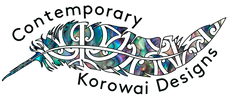A modern take on the Māori cloak
Traditionally, Kahu Huruhuru and Kahu Kiwi were Māori cloaks made from woven flax fibre and decorated with the feathers of native New Zealand bids including tūī, kākā, kereru and kiwi. The rarity of the birds that the feathers came from, the difficulty of gathering enough feathers (such as the white throat feathers of the tūī which each bird only has two of) and the respect in which each bird was held, all added to the prestige associated with each cloak.
A small number of traditional Korowai and Kākahu are still made by weavers from different Iwi, using methods and materials that have not changed in many hundreds of years. One big difference is that when feathers from native birds are used, they are often from birds that have died as a result of accidents and have been passed onto iwi representatives by organisations such as DOC and bird sanctuaries.
Contemporary Korowai
Here at Contemporary Korowai Designs we understand how important and empowering wearing a korowai can be for whanau attending special occasions and events. That’s why we have developed our modern versions of Korowai that anyone can afford, and that produced in a way that are sustainable, and bring benefits to the people in the community where they are made.
Hand crafted
All our Korowai are hand crafted by our dedicated team. We use a mixture of traditional techniques, and modern materials to make Māori cloaks that look great, whether worn or on display, and give many years of happiness to the people that receive them.
We make all our Korowai in our workshop in Wainuiomata, and are proud to use local people, including fire and emergency volunteers, to produce them. Local businesses are vital to local economies and communities, and we enjoy playing our part in that.
Sustainability
Kaitiakitanga, or guardianship and protection of the natural environment, is an important concept for Māori, and increasingly many other New Zealanders. The traditional use of feathers from native birds in Korowai and Kākahu isn’t appropriate or possible these days, so instead we use high quality feathers from chickens and roosters. These feathers are permanently dyed the colours that we use when creating our Korowai.
Traditional and modern Tāniko bands
We use three different designs on the pre woven Tāniko bands that we sell as head bands and use in the construction of our Korowai.
One of the designs, Aramoana, is a traditional Māori weaving pattern. The name means Pathway of the Sea, and the zigzags of the design represent ocean waves.
The other two designs that we use are modern and have been designed by members of our family.
Moroki was created by my 23yr old daughter Jade Paki (Ngati Apa & Ngati Tuwharetoa). She named it Moroki which means modern or contemporary.

Whanake was designed by my brother-in-law Horace Taiapa and is based on the teeth of the niho taniwha. It was named Whanake by his daughter Ani, and it means to grow and develop.

Korowai for sale
We have a wide range of designs of Korowai that we make and sell, in three different lengths, full, haurua (half) and hauwha (quarter). Choose a length that matches that look you want, as well as how and where the Korowai is going to be worn.
We generally only have a few Korowai in stock at any one time, and make most of our Korowai to order. We are always busy, and lead times are usually 2 – 4 weeks. If you need a Korowai urgently, please contact us and we’ll see what we can do to accommodate your order.


